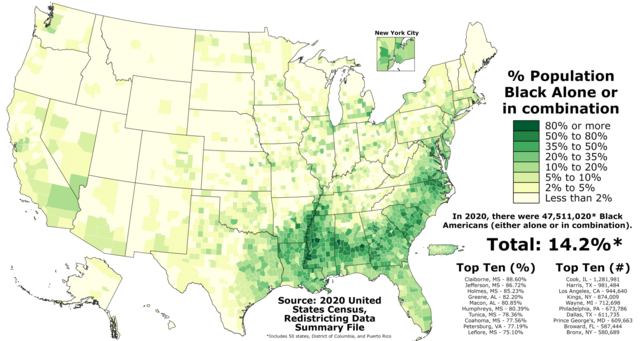Top Qs
Timeline
Chat
Perspective
List of U.S. states and territories by African-American population
From Wikipedia, the free encyclopedia
Remove ads
The following is a list of U.S. states, territories and the District of Columbia ranked by the proportion of African Americans of full or partial descent, including those of Hispanic origin, in the population. Considering only those who marked "black" and no other race in combination, as in the first table, the percentage was 12.4% in 2020, down from 12.6% in 2010.[1] Considering those who marked "black" and any other race in combination, as in the second table, the percentage increased from 13.6% to 14.2%.

Proportion of African Americans in each U.S. state, the District of Columbia, and Puerto Rico as of the 2020 United States Census

Proportion of black Americans in each county of the fifty states, the District of Columbia and Puerto Rico as of the 2020 United States Census
Remove ads
2020 census (single race)
Remove ads
African-American proportion of state and territory populations (1790–2020)
Summarize
Perspective
From 1787 to 1868, enslaved African Americans were counted in the U.S. census under the Three-fifths Compromise. The compromise was an agreement reached during the 1787 United States Constitutional Convention over the counting of slaves in determining a state's total population. This count would determine the number of seats for each state in the U.S. House of Representatives and, should direct taxation be imposed by Congress (which was never done under Article I, section 2, clause 3 of the Constitution), how much each state would pay in taxes. The compromise counted three-fifths of each state's slave population toward that state's total population for the purpose of apportioning the U.S. House of Representatives. Even though slaves were denied voting rights, this gave Southern states more U.S. representatives and more presidential electoral votes than if slaves had not been counted. Free blacks and indentured servants were not affected by the proviso, and each was counted as one full person for representation.[7]
In the United States Constitution, the Three-fifths Compromise is part of Article 1, Section 2, Clause 3. Section 2 of the Fourteenth Amendment (1868) later superseded this clause and explicitly repealed the compromise.
This graph was using the legacy Graph extension, which is no longer supported. It needs to be converted to the new Chart extension. |
Free blacks as a percentage out of the total black population by U.S. region and U.S. state between 1790 and 1860
In 1865, all enslaved blacks (African Americans) in the United States were emancipated as a result of the Thirteenth Amendment. However, some U.S. states had previously emancipated some or all of their black population. The table below shows the percentage of free blacks as a percentage of the total black population in various U.S. regions and U.S. states between 1790 and 1860 (the blank areas on the chart below mean that there is no data for those specific regions or states in those specific years).[citation needed]
a^ No blacks, whether free or enslaved, were reported as living in South Dakota in 1860.[14]
Remove ads
See also
References
Wikiwand - on
Seamless Wikipedia browsing. On steroids.
Remove ads
